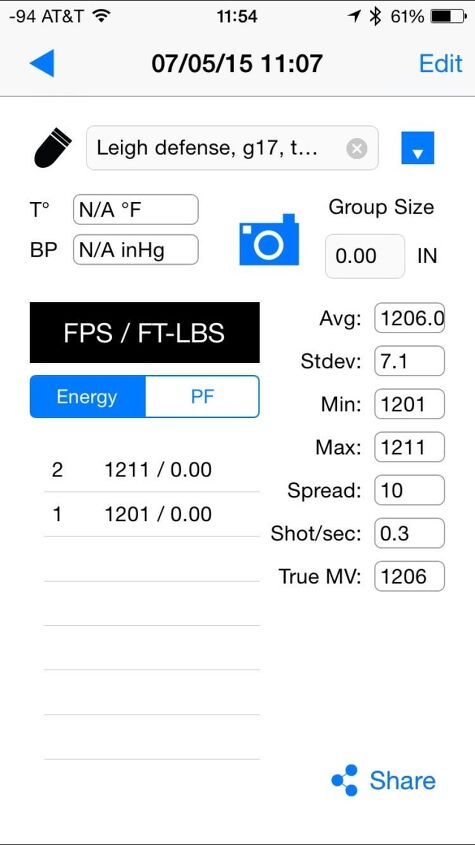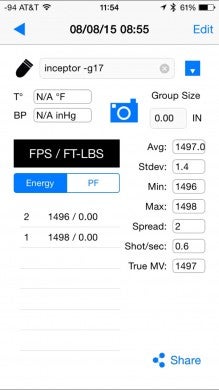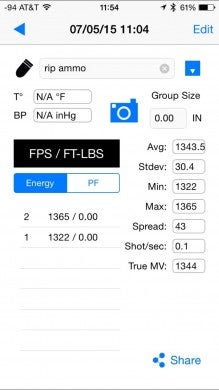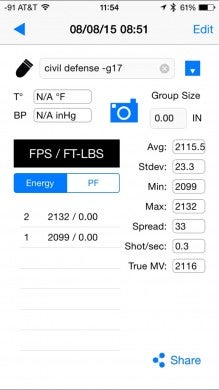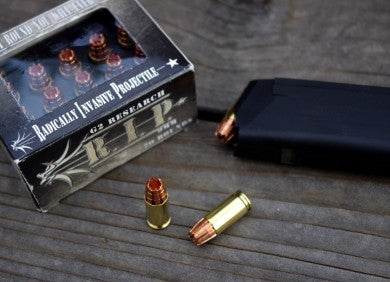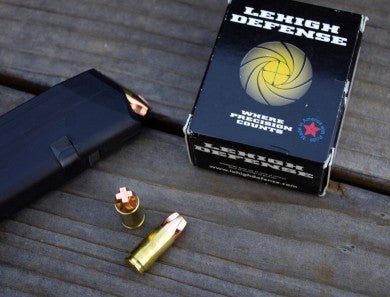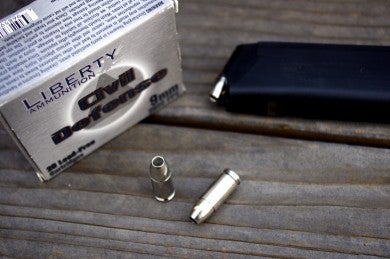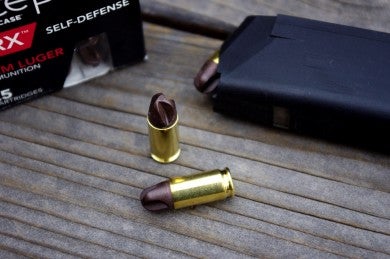Shooting Ballistic Gel
Thomas Gomez and I were approached about doing a test shoot of four different defense rounds:
- 9 millimeter Radically Invasive Projectile, R.I.P from G2 Research.
- 9 millimeter Xtreme Penetrator from Lehigh Defense.
- 9 millimeter Inceptor ARX from Polycase
- 9 millimeter Civil Defense from Liberty Ammunition.
The company that made the request, strangely, was not a manufacturer–it was Clark Armory. They were interested in having TFB perform an independent review (though pseudo-scientific as we will explain later) of some of the defense rounds that they sell. Of course we accepted.
Disclosure: They did not pay for this review though they did send us two boxes of each of the four rounds, two ballistic gels from Clear Ballistics (and the necessary stuff to reset the gels for reuse). All of the other materials we provided along with nine range trips, and the countless hours Thomas Gomez spent melting and resetting the gels.
Materials
The gel itself is pretty cool. It is reusable with a little bit of work. The gel can be reused 12-15 times and is temperature stable. Compare that to more traditional gels that are super finicky (like have to be kept at a certain temperature, can only sit for a few hours, etc). Thomas Gomez has written a specific article on working with the gel which is a pretty interesting read in, and of, itself.
After discussing a plan of action and working out the logistics we decided to run four (out of the “standard” eight) of the “FBI Ballistic Tests”. We’d like to note that we did not find an “official” detail of an FBI testing protocol–just a mega ton of search results that discuss them. The closest we came to something official was listed in the “FBI Law Enforcement Bulletin (November 1989, Volume 58, Number 11, Page 5)” (https://www.ncjrs.gov/pdffiles1/Digitization/122334NCJRS.pdf). With two gels and four different rounds, completing four tests would take us eight sessions, assuming nothing went wrong requiring a reshoot.
Some of our more astute readers will likely be thinking, “Why didn’t you fools just shoot multiple times on the same gel?”. Well, some of the cavitation channels were very large and the gel was disrupted pretty heavily. We wanted each test to be against as pristine gel as we could provide (a task which became increasingly challenging as the test went on and you will see).
Method To Our Madness
The plan was to shoot on bare gel, gel covered with heavy clothing, gel behind drywall, and gel behind automotive glass in accordance with the four FBI tests we had chosen. We chose these tests (and eschewed the others) for their probability of being the most common usage in a defense situation. I suppose some could argue that the plywood is more relevant than automotive glass, but this is what we decided… 🙂
The FBI Law Enforcement Bulletin discusses the minimum preferable penetration as 12 inches and a maximum of 18 inches. Our blocks were 16 inches long, so we would not be able to assess the maximum distance dimension without sacrificing the second block and significantly extending our testing.
We used a Generation 2 Glock 17 for the primary tests, but we did fire each of the rounds (and chrono them) with a Generation 3 Glock 19. Mainly we just wanted to assess if there was any significant loss of velocity between the two platforms.
Since all of the rounds had different published grains and velocities we also wanted to chrono them for verification. We used our chronograph to verify the stated velocity of the rounds and all four rounds were within stated specs as you can see below.
Bare gel should be obvious as a baseline–we need to see how the rounds perform in the testing medium without any external interference. Though, I suppose the results of the test would be relevant for shooting a naked intruder (assuming you missed all bones).
Heavy clothing (as defined by the FBI “standard”) is a light cotton layer, heavy cotton shirt, 200W Fleece, and denim. This is probably the most common way you are going to encounter an adversary in a “defense” scenario. It should be noted that we adapted the clothing test from the original as stated in the FBI Law Enforcement Bulletin (which utilized 10 oz. down in a nylon carrier)–we used 200W fleece instead.
Drywall is probably the most common building material internal to dwellings these days, so we opted for that as our third test. We built a simple frame with “studs” spaced at 16 inches, and had two layers of drywall, unpainted and untextured). In our implementation, we did not actually fill the gap with insulation (solely because cleaning fiberglass out of the wound channels in the gel would have been nigh impossible).
Our final test was shooting through automotive glass. Why? Because why not. Super fun. But also relevant if someone is using a car as a weapon against you. I imagine this scenario would be more relevant to our law enforcement officers than general public, though. In fact, in Albuquerque, we had a situation a couple of years ago that a well placed round through a windshield could have mitigated (“suspect” stole a cop car, chaos ensued).
Our setup was using two X-Workhorse Workbenches from Home Depot, a Caldwell Steady NXT Rifle and Pistol rest, Caldwell Ballistic Precision Chronograph Premium Kit, and couple of GoPro Hero 4 cameras (my personal one, and one donated for use by BMC Tactical). Though, as you will see later, this setup plan did not survive contact with the automotive glass test–somehow the inside of my Jeep became the shooting platform… 🙂
Also we learned a lot about using GoPro cameras. We apologize in advance for some of the crappier videos (our initial videos we did not set the mode for max frame rate, and on some of the videos we had bad lighting angles/glare, or obscured views from the clothing). This was certainly a learning experience throughout.
The Rounds
As we said, Clark Armory graciously provided us with with two boxes of each of the rounds for testing. Below are some details about each of the rounds.
Radically Invasive Projectile (R.I.P.)
The Radically Invasive Projectile, from G2 Research is a solid copper 96 grain 9 millimeter projectile. Key features of the Radically Invasive Projectile include:
- 14 to 16 inches of Penetration.
- 2 inch groups at 25 yards.
- The G2 R.I.P round creates 9 separate wound channels.
- Velocity of 1,265 feet per second.
- 6 inch diameter wound spread.
- The G2 R.I.P round is advertised to defeat sheet metal, windshields, plywood, sheet rock and heavy clothing.
For testing, Clark Armory provided 40 rounds of 9 millimeter G2 R.I.P ammunition.
Lehigh Defense
The Xtreme Penetrator from Lehigh Defense is CNC machined from a solid piece of copper. For testing we were provided 40 rounds of 115 grain 9mm Xtreme Penetrator. Key features include:
- 23 inches of penetration.
- Velocity of 1,150 feet per second.
- Permanent wound channel that is 1.5 inches across.
- Radial flutes that the manufacturer claims, forces hydraulic energy inward, increasing pressure.
- “Progressive nose geometry for deep straight penetration”
For testing, Clark Armory provided 40 rounds of 9 millimeter Lehigh Defense ammunition.
Civil Liberty Defense
Civil Defense, from Liberty Ammunition, is a 50 grain lead free 9 millimeter, hollow point bullet. The Civil defense round is designed to transfer its energy by heavy fragmentation upon hitting a target. Key features of the Civil Defense round include:
- Velocity of 2000 feet per second
- 2 inch dispersion/wound channel
- Lead free
For testing, Clark Armory provided 40 rounds of 50 grain Civil Defense ammunition in 9 millimeter
Inceptor
Inceptor ARX, from Polycase Ammunition, is a 74 grain 9 millimeter, injection molded polymer copper round designed to penetrate soft tissue and break apart when subjected to a solid medium. Key features of Polycase’s Inceptor ARX:
- Velocity of 1,475 feet per second.
- The ARX bullet is composed of a blended copper polymer matrix.
- The Inceptor ARX is not designed to expand.
- The Inceptor ARX bullet transfers energy through “lateral force dispersion”
For testing, Clark Armory provided 50 rounds of Inceptor ARX ammunition in 9 millimeter.
Sessions
We are breaking this article into six parts: Introduction (what you are reading now), one part for each of the media/tests, and a post for our overall observations and conclusions. Each post will have links to the other parts for ease of navigation.
Some of the rationale for doing it this way is to keep discussions on the various tests more focused and relevant as well as break up a article with a dozen videos and over five thousand words into more manageable chunks.
Articles in Series
Note: The below links are not immediately live. Each part will be released a day apart (by Dec 7th all should be available).
Introduction
Session 1 – Bare Gel
Session 2 – Heavy Clothing
Session 3 – Automotive Glass
Session 4 – Drywall
Observations and Conclusion
 Your Privacy Choices
Your Privacy Choices

